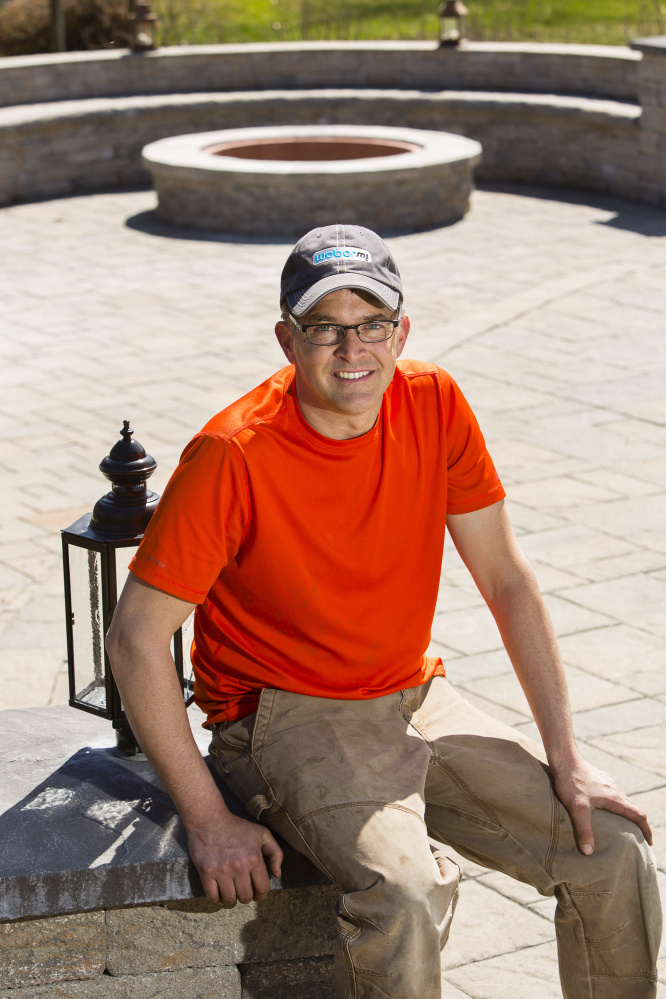Ken Fengler left behind careers in teaching and computers to start his own landscaping and hardscaping business; economic safety not guaranteed but the pleasure and satisfaction of spending his days outside certainly is. In the wake of recent moves toward a pesticide ban in South Portland, we wanted to talk to a landscaper who is already working without fertilizers or pesticides. When we called Fengler, he was on his way out to the Winslow Homer Studio, one of many properties he takes care of at Prouts Neck.
He told us about getting his start in that beautiful coastal community as a high school student mowing lawns, clued us in about the environmental costs of asphalt versus pavers and talked about how the tendency of developers to maximize profits can lead to a very unsustainable lawn. And, OK, we confess to steering the conversation toward getting some free advice on how to improve our lawn.
BACKSTORY: Fengler grew up on a tree farm in Scarborough, where he helped his parents maintain a woodlot for lumber. (Lots of trimming and thinning to get it ready for foresters.) But family-rate wages topped off around $5 an hour, so in high school he and his brother signed up for lawn-mowing jobs. They worked for landscapers Rick Powell and Larry Salamone, who became mentors. “I just soaked up everything they were willing to share with me, like a sponge.” Fengler worked summers with them all through college (he studied zoology at the University of Maine) and after, even when he had started teaching biological science at various high schools.
HOT STUFF: The trendy thing his clients are asking for? Hardscaping that makes outdoor entertaining easier. And prettier. “The word is outdoor living. Almost every project we talk about these days they want a fire pit. And they don’t just want six rocks in a circle sitting around.” They want plenty of room for couches and tables. California style; it’s coming to Maine.
UNDER THE SURFACE: That’s the superficial stuff. The good news for the environment is that municipal policies, like Portland’s hike in stormwater fees (which went into effect in January) mean more homeowners are creating permeable surfaces on their properties. Most polluted runoff comes from paved areas, which act as catch-alls for chemicals and then steer them into storm drains and eventually, to the Gulf of Maine. The fewer non-permeable surfaces a landowner has, the less they’ll have to pay in taxes. Thus, his Portland clients have started asking for pavers instead of asphalt driveways. They’re more expensive upfront, but Fengler says asphalt starts breaking down after eight years, while pavers can last 30. “You’d actually come out ahead. If you have that driveway repaved three times, think about the cost.” Not to mention, the environmental savings.
PET PEEVE: Fengler attributes the worst trend in lawn care to new development. When builders clear lots for new construction, he said, they typically scrape away all the natural topsoil, pushing it to one side. Then they cart most of it away. “They will start selling that soil,” he said. “And then they will put back the minimal amount possible to support the lawn.”
TIP TOP TOPSOIL: Thus the homeowner ends up in a bind. Their new lawns look good, but not for long. They need sprinkler systems. Or fertilizers. “They want the property to look nice and they feel that the only way they achieve this is fertilizer.” That’s the cheap fix, Fengler said. But run-off from fertilizers is a major contributor to declining water quality in Casco Bay (Fengler’s wife used to work for Friends of Casco Bay, and he practices what the group preaches).
Replacing a dying lawn with fresh sod tends to be just a temporary fix. “When sod is cut, a large part of the root system is left behind,” he said. “The only way to keep it going is to fertilize and water the daylights out of it. So now you have built this unsustainable system.”
STARTING OVER: As with most things, Fengler said the best way is to start with the best practice: growing a new lawn in good soil from good seed. That’s why sometimes he recommends clients start over, carting in yards of topsoil and organic compost and then replanting grass. It’s the more environmentally conscious way to go, and ultimately, it may cost about the same. Rhapsodizing about a property he takes care of on Prouts Neck, Fengler says: “The topsoil is about a foot deep and the owner doesn’t have to fertilize, he doesn’t have to water; that’s because the lawn has the organic material there to do it on its own.”
THE FIRST AMENDMENT: Can’t afford to start over? Fengler says a layer of compost can be a real pick-me-up for sad patches of grass. “Cut the grass short first and then put it on. The nice thing about compost is, it is relatively light and airy. If you put a thin coat on, it won’t suffocate the grass.” How much? Start with a half-inch and then add a little more a week or so later. “It is going to get healthier.”
SHOW US YOURS: What’s Fengler’s own backyard like? “I probably have more compost in my garden than anyone else you know.” He doesn’t have to water or fertilize, but he admits that he’s like the house painter with the peeling exterior on his own house. “I am that person. Please don’t street-view my house.” He has a patio, and he’s started on some landscaping. “Someday I will get there,” he said. Meanwhile, “it is hard to turn down a paycheck.”
Send questions/comments to the editors.




Comments are no longer available on this story